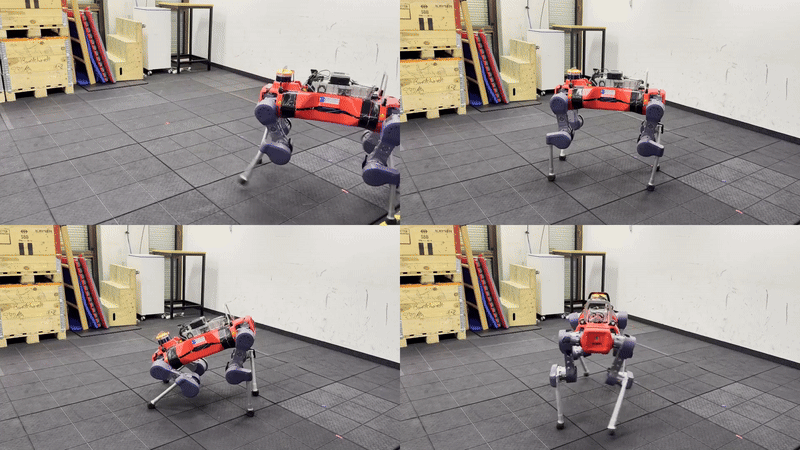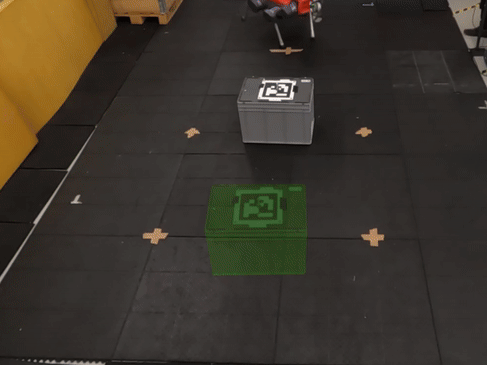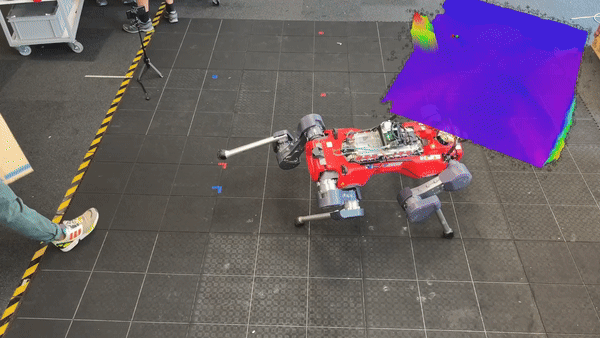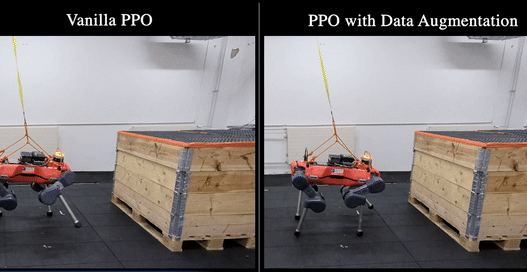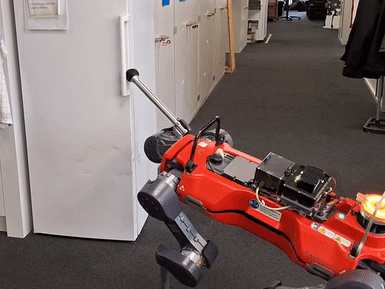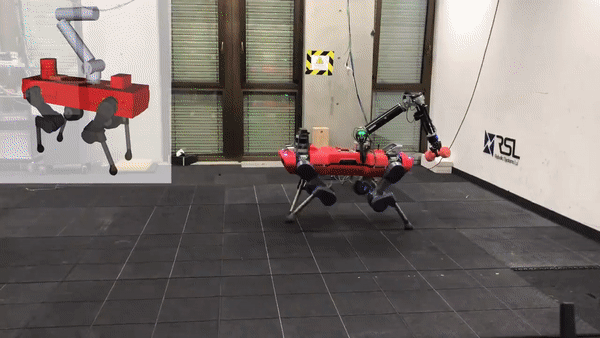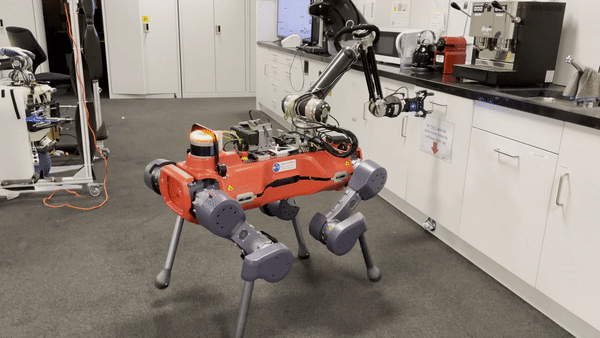I am currently a final-year PhD student at ETH Zurich, advised by Marco Hutter, and a Research Scientist at NVIDIA.
My research explores how robots can learn to reason about their bodies and surroundings to achieve more adaptive and
versatile behaviors. This includes whole-body control for mobile manipulation, reinforcement learning for contact-rich tasks, and integrating multi-modal sensing to enhance decision-making.
If you have any questions or would like to discuss ideas, feel free to reach out via
email!
news
| Sep 21, 2025 |
Our paper on ‘SonoGym: High Performance Simulation for Challenging Surgical Tasks with Robotic Ultrasound’ is accepted
at NeurIPS 2025 Datasets & Benchmarks Track
|
| Sep 10, 2025 |
Our paper on ‘Factorized Skill Learning with Symmetry and Style Priors’ is accepted for an oral
presentation at CoRL 2025
|
| Jun 20, 2025 |
Honored to be a part of RSS Pioneers 2025 which brings together a cohort of the world’s top early-career researchers
|
| Feb 6, 2025 |
Two papers on quadrupedal mobile manipulation for whole-body end-effector pose tracking and dynamic object pushing accepted to ICRA 2025
|
| Oct 18, 2024 |
Our paper on ‘Guided Reinforcement Learning for Robust Multi-Contact Loco-Manipulation’ is accepted for an oral
presentation at CoRL 2024 
|
selected publications
-
Divide, Discover, Deploy: Factorized Skill Learning with Symmetry and Style Priors
Rafael Cathomen,
Mayank Mittal,
Marin Vlastelica,
and Marco Hutter
CoRL
2025
| Oral (top 6%)
[Abs]
[arXiv]
[Website]
Unsupervised Skill Discovery (USD) allows agents to autonomously learn diverse behaviors without task-specific rewards. While recent USD methods have shown promise, their application to real-world robotics remains under-explored. We propose a modular USD framework that employs user-defined factorization of the state space to learn disentangled skill representations. Different skill discovery algorithms (METRA, DIAYN) are assigned to each factor based on the desired behavior. We introduce symmetry-based inductive biases tailored to individual factors and incorporate a style factor with regularization penalties to promote safe and robust behaviors. We evaluate our framework using a quadrupedal robot (ANYmal-D) and demonstrate zero-shot transfer of learned skills to real hardware. Our results show that factorization and symmetry lead to structured, human-interpretable behaviors, while the style factor enhances safety and diversity. The learned skills perform on par with oracle policies on downstream navigation tasks.
-
Whole-Body End-Effector Pose Tracking
Tifanny Portela,
Andrei Cramariuc,
Mayank Mittal,
and Marco Hutter
ICRA
2025
[Abs]
[arXiv]
Combining manipulation with the mobility of legged robots is essential for a wide range of robotic applications. However, integrating an arm with a mobile base significantly increases the system’s complexity, making precise end-effector control challenging. Existing model-based approaches are often constrained by their modeling assumptions, leading to limited robustness. Meanwhile, recent Reinforcement Learning (RL) implementations restrict the arm’s workspace to be in front of the robot or track only the position to obtain decent tracking accuracy. In this work, we address these limitations by introducing a whole-body RL formulation for end-effector pose tracking in a large workspace on rough, unstructured terrains. Our proposed method involves a terrain-aware sampling strategy for the robot’s initial configuration and end-effector pose commands, as well as a game-based curriculum to extend the robot’s operating range. We validate our approach on the ANYmal quadrupedal robot with a six DoF robotic arm. Through our experiments, we show that the learned controller achieves precise command tracking over a large workspace and adapts across varying terrains such as stairs and slopes. On deployment, it achieves a pose-tracking error of 2.64 cm and 3.64 degrees, outperforming existing competitive baselines.
-
Dynamic Object Goal Pushing with Mobile Manipulators through Model-Free Constrained Reinforcement Learning
Ioannis Dadiotis,
Mayank Mittal,
Nikos Tsagarakis,
and Marco Hutter
ICRA
2025
[Abs]
[arXiv]
Non-prehensile pushing to move and reorient objects to a goal is a versatile loco-manipulation skill. In the real world, the object’s physical properties and friction with the floor contain significant uncertainties, which makes the task challenging for a mobile manipulator. In this paper, we develop a learning-based controller for a mobile manipulator to move an unknown object to a desired position and yaw orientation through a sequence of pushing actions. The proposed controller for the robotic arm and the mobile base motion is trained using a constrained Reinforcement Learning (RL) formulation. We demonstrate its capability in experiments with a quadrupedal robot equipped with an arm. The learned policy achieves a success rate of 91.35% in simulation and at least 80% on hardware in challenging scenarios. Through our extensive hardware experiments, we show that the approach demonstrates high robustness against unknown objects of different masses, materials, sizes, and shapes. It reactively discovers the pushing location and direction, thus achieving contact-rich behavior while observing only the pose of the object. Additionally, we demonstrate the adaptive behavior of the learned policy towards preventing the object from toppling.
-
Guided Reinforcement Learning for Robust Multi-Contact Loco-Manipulation
Jean-Pierre Sleiman*,
Mayank Mittal*,
and Marco Hutter
CoRL
2024
| Oral (top 6%)
[Abs]
[arXiv]
[Website]
Reinforcement learning (RL) often necessitates a meticulous Markov Decision Process (MDP) design tailored to each task. This work aims to address this challenge by proposing a systematic approach to behavior synthesis and control for multi-contact loco-manipulation tasks, such as navigating spring-loaded doors and manipulating heavy dishwashers. We define a task-independent MDP to train RL policies using only a single demonstration per task generated from a model-based trajectory optimizer. Our approach incorporates an adaptive phase dynamics formulation to robustly track the demonstrations while accommodating dynamic uncertainties and external disturbances. We compare our method against prior motion imitation RL works and show that the learned policies achieve higher success rates across all considered tasks. These policies learn recovery maneuvers that are not present in the demonstration, such as re-grasping objects during execution or dealing with slippages. Finally, we successfully transfer the policies to a real robot, demonstrating the practical viability of our approach.
-
Perceptive Pedipulation with Local Obstacle Avoidance
Jonas Stolle,
Philip Arm,
Mayank Mittal,
and Marco Hutter
ICHR
2024
| Best Interactive Poster Finalist
[Abs]
[arXiv]
[Website]
Pedipulation leverages the feet of legged robots for mobile manipulation, eliminating the need for dedicated robotic arms. While previous works have showcased blind and task-specific pedipulation skills, they fail to account for static and dynamic obstacles in the environment. To address this limitation, we introduce a reinforcement learning-based approach to train a whole-body obstacle-aware policy that tracks foot position commands while simultaneously avoiding obstacles. Despite training the policy in only five different static scenarios in simulation, we show that it generalizes to unknown environments with different numbers and types of obstacles. We analyze the performance of our method through a set of simulation experiments and successfully deploy the learned policy on the ANYmal quadruped, demonstrating its capability to follow foot commands while navigating around static and dynamic obstacles.
-
Symmetry Considerations for Learning Task Symmetric Robot Policies
Mayank Mittal*,
Nikita Rudin*,
Victor Klemm,
Arthur Allshire,
and Marco Hutter
ICRA
2024
[Abs]
[arXiv]
[Code]
Symmetry is a fundamental aspect of many real-world robotic tasks. However, current deep reinforcement learning (DRL) approaches can seldom harness and exploit symmetry effectively. Often, the learned behaviors fail to achieve the desired transformation invariances and suffer from motion artifacts. For instance, a quadruped may exhibit different gaits when commanded to move forward or backward, even though it is symmetrical about its torso. This issue becomes further pronounced in high-dimensional or complex environments, where DRL methods are prone to local optima and fail to explore regions of the state space equally. Past methods on encouraging symmetry for robotic tasks have studied this topic mainly in a single-task setting, where symmetry usually refers to symmetry in the motion, such as the gait patterns. In this paper, we revisit this topic for goal-conditioned tasks in robotics, where symmetry lies mainly in task execution and not necessarily in the learned motions themselves. In particular, we investigate two approaches to incorporate symmetry invariance into DRL – data augmentation and mirror loss function. We provide a theoretical foundation for using augmented samples in an on-policy setting. Based on this, we show that the corresponding approach achieves faster convergence and improves the learned behaviors in various challenging robotic tasks, from climbing boxes with a quadruped to dexterous manipulation.
-
Pedipulate: Enabling Manipulation Skills using a Quadruped Robot’s Leg
Philip Arm,
Mayank Mittal,
Hendrik Kolvenbach,
and Marco Hutter
ICRA
2024
[Abs]
[arXiv]
[Video]
[Website]
Legged robots have the potential to become vital in maintenance, home support, and exploration scenarios. In order to interact with and manipulate their environments, most legged robots are equipped with a dedicated robot arm, which means additional mass and mechanical complexity compared to standard legged robots. In this work, we explore pedipulation - using the legs of a legged robot for manipulation. By training a reinforcement learning policy that tracks position targets for one foot, we enable a dedicated pedipulation controller that is robust to disturbances, has a large workspace through whole-body behaviors, and can reach far-away targets with gait emergence, enabling loco-pedipulation. By deploying our controller on a quadrupedal robot using teleoperation, we demonstrate various real-world tasks such as door opening, sample collection, and pushing obstacles. We demonstrate load carrying of more than 2.0 kg at the foot. Additionally, the controller is robust to interaction forces at the foot, disturbances at the base, and slippery contact surfaces.
-
ORBIT: A Unified Simulation Framework for Interactive Robot Learning Environments
Mayank Mittal,
Calvin Yu,
Qinxi Yu,
Jingzhou Liu,
Nikita Rudin,
David Hoeller,
and others
IEEE RA-L
2023
| renamed to NVIDIA Isaac Lab
[Abs]
[arXiv]
[Website]
[Code]
We present ORBIT, a unified and modular framework for robot learning powered by NVIDIA Isaac Sim. It offers a modular design to easily and efficiently create robotic environments with photo-realistic scenes and fast and accurate rigid and deformable body simulation. With ORBIT, we provide a suite of benchmark tasks of varying difficulty – from single-stage cabinet opening and cloth folding to multi-stage tasks such as room reorganization. To support working with diverse observations and action spaces, we include fixed-arm and mobile manipulators with different physically-based sensors and motion generators. ORBIT allows training reinforcement learning policies and collecting large demonstration datasets from hand-crafted or expert solutions in a matter of minutes by leveraging GPU-based parallelization. In summary, we offer an open-sourced framework that readily comes with 16 robotic platforms, 4 sensor modalities, 10 motion generators, more than 20 benchmark tasks, and wrappers to 4 learning libraries. With this framework, we aim to support various research areas, including representation learning, reinforcement learning, imitation learning, and task and motion planning. We hope it helps establish interdisciplinary collaborations in these communities, and its modularity makes it easily extensible for more tasks and applications in the future.
-
A Collision-Free MPC for Whole-Body Dynamic Locomotion and Manipulation
Jia-Ruei Chiu,
Jean-Pierre Sleiman,
Mayank Mittal,
Farbod Farshidian,
and Marco Hutter
ICRA
2022
[Abs]
[arXiv]
[Video]
[Code]
In this paper, we present a real-time whole-body planner for collision-free legged mobile manipulation. We enforce both self-collision and environment-collision avoidance as soft constraints within a Model Predictive Control (MPC) scheme that solves a multi-contact optimal control problem. By penalizing the signed distances among a set of representative primitive collision bodies, the robot is able to safely execute a variety of dynamic maneuvers while preventing any self-collisions. Moreover, collision-free navigation and manipulation in both static and dynamic environments are made viable through efficient queries of distances and their gradients via a euclidean signed distance field. We demonstrate through a comparative study that our approach only slightly increases the computational complexity of the MPC planning. Finally, we validate the effectiveness of our framework through a set of hardware experiments involving dynamic mobile manipulation tasks with potential collisions, such as locomotion balancing with the swinging arm, weight throwing, and autonomous door opening.
-
Articulated Object Interaction in Unknown Scenes with Whole-Body Mobile Manipulation
Mayank Mittal,
David Hoeller,
Farbod Farshidian,
Marco Hutter,
and Animesh Garg
IROS
2022
[Abs]
[arXiv]
[Website]
A kitchen assistant needs to operate human-scale objects, such as cabinets and ovens, in unmapped environments with dynamic obstacles. Autonomous interactions in such real-world environments require integrating dexterous manipulation and fluid mobility. While mobile manipulators in different form-factors provide an extended workspace, their real-world adoption has been limited. This limitation is in part due to two main reasons: 1) inability to interact with unknown human-scale objects such as cabinets and ovens, and 2) inefficient coordination between the arm and the mobile base. Executing a high-level task for general objects requires a perceptual understanding of the object as well as adaptive whole-body control among dynamic obstacles. In this paper, we propose a two-stage architecture for autonomous interaction with large articulated objects in unknown environments. The first stage uses a learned model to estimate the articulated model of a target object from an RGB-D input and predicts an action-conditional sequence of states for interaction. The second stage comprises of a whole-body motion controller to manipulate the object along the generated kinematic plan. We show that our proposed pipeline can handle complicated static and dynamic kitchen settings. Moreover, we demonstrate that the proposed approach achieves better performance than commonly used control methods in mobile manipulation.

